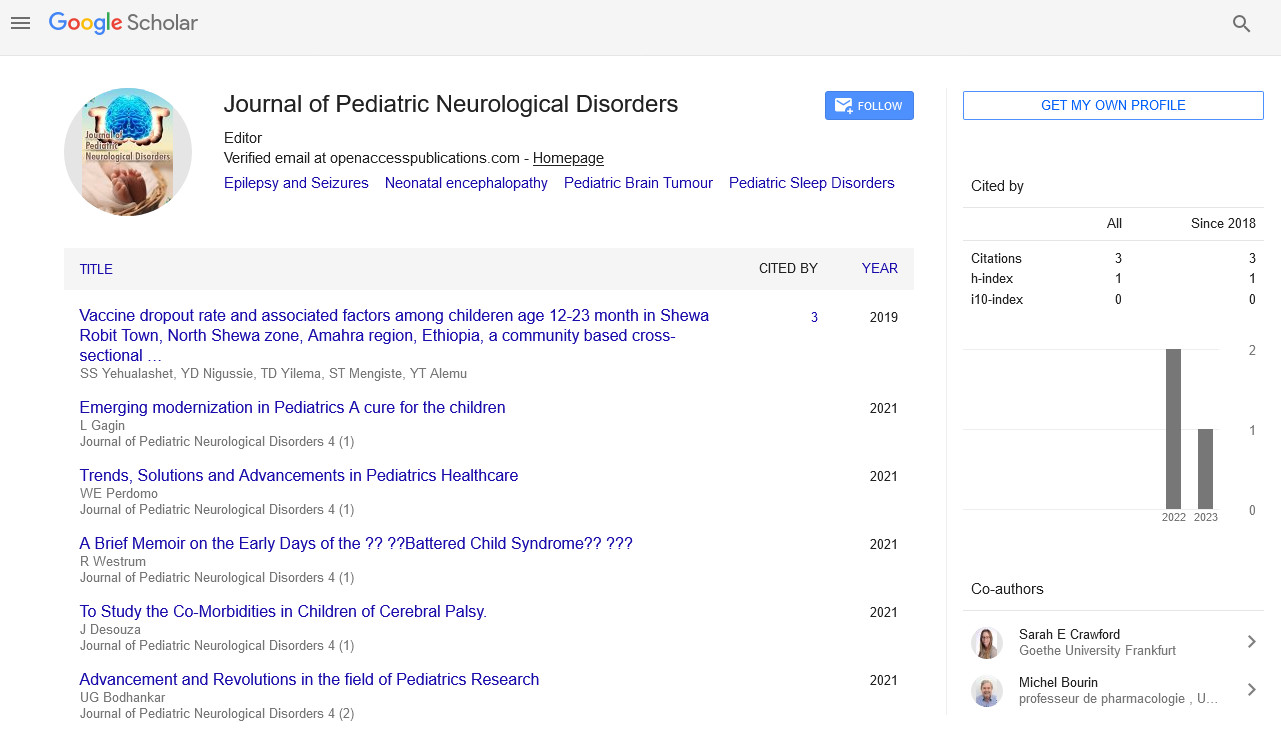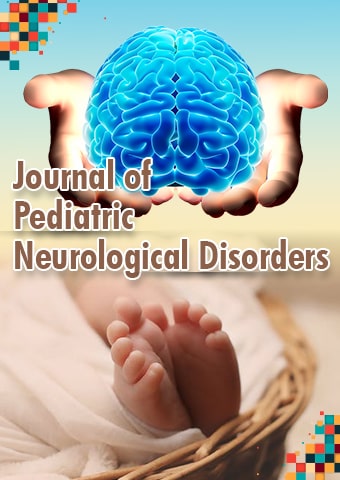Mini Review - Journal of Pediatric Neurological Disorders (2023) Volume 6, Issue 4
Interventions for dyslexic children: An overview of contemporary intervention techniques
Dario Decenty*
Department of Pediatrics, University of Lille
Department of Pediatrics, University of Lille
E-mail: dario3@ul.ac.fr
Received: 01-Aug-2023, Manuscript No. pnn-23-111119; Editor assigned: 07-Aug-2023, PreQC No. pnn-23- 111119(PQ); Reviewed: 14- Aug- 2023, QC No. pnn-23-111119; Revised: 22-Apr-2023, Manuscript No. pnn-23-111119; Published: 31-Aug-2023, DOI: 10.37532/ pnn.2023.6(4).87-90
Abstract
Introduction
A neurological condition called dyslexia predominantly impacts reading abilities. It is typically recognized at the pre-school level and is commonly referred to as a reading issue. It is likely present at birth. Dyslexia is characterized by issues with precise word recognition as well as by subpar reading and writing ability.
Method
This paper's major goal is a study of the many approaches or interventions utilized, notably in Malaysia, to manage the cognitive and literacy skills of dyslexic children. The publications were gathered over a six-year period, from 2000 to 2016, using internet databases like PubMed, Ebscohost, and Medline. Only 13 of the 300 articles that were initially created met the inclusive criteria.
Results
The multisensory approach, phonological intervention, and cognitive training method are a few types of interventions that can be used to help dyslexic children with their literacy and cognitive deficiencies. In Malaysia, the majority of therapies concentrate on language-related skills such word knowledge, letter recognition, and writing abilities. To enhance particular domains, such as visuospatial, memory, and psychomotor skills, cognitive training was conducted.
Conclusion
There are currently no studies that have combined the intervention of cognitive functions and linguistics-literacy deficiencies in a comprehensive manner. It is crucial that Malaysian academics look beyond literacy abilities and investigate the underlying cognitive processes that contribute to the distinct reading and writing challenges faced by Malaysian children with dyslexia.
Keywords
Dyslexia • Cognitive deficiencies • Psychomotor skills • Visuo spatial • Psychomotor skills • Cognitive training
Introduction
Executive control or higher-order processing skills are impaired in dyslexic children. In addition, they struggle with visual attention span, which has a significant impact on their reading ability. In addition to having trouble identifying letters, children with dyslexia may also have trouble memorizing. The majority of dyslexic students exhibit serious speed, verbal working memory, and phonological processing problems. According to a study by the International Dyslexia Association, dyslexia affects 10%–15% of people worldwide. In Malaysia, 10%–15% of elementary school students were found to have dyslexic symptoms, according to Harmonic Social Association (PSHM). The Department of Special Education, Ministry of Education of Malaysia reports that there are around 314,000 dyslexic children in Malaysia. According to the Ministry of Education Malaysia, one out of every 20 students has been found to have dyslexia. According to the Sin Chew Daily, the disorder affects around 10% of primary and secondary school students [1].
According to a study by the International Dyslexia Association, dyslexia affects 10%–15% of people worldwide.8 In Malaysia, 10%–15% of elementary school students were found to have dyslexic symptoms, according to Harmonic Social Association (PSHM). The Department of Special Education, Ministry of Education of Malaysia reports that there are around 314,000 dyslexic children in Malaysia. According to the Ministry of Education Malaysia, one out of every 20 students has been found to have dyslexia. According to the Sin Chew Daily, the disorder affects around 10% of primary and secondary school students [2].
Problem with the statement
It is clear that children with dyslexia have been impacted by the disorder's challenges in a variety of ways. To meet their requirements, it is crucial to have established intervention strategies in place. There are currently only a few modules or intervention programs being run in Malaysia for kids with dyslexia. In Malaysian public schools, there isn't even a standardized module for the dyslexia class yet [3].
Teachers in schools place a greater emphasis on training cognitive skills than literacy abilities, such as reading and writing, for pupils with dyslexia. These children's outcomes were found to be uninspiring and unsuccessful in resolving their reading issues since teachers tended to employ traditional ways to help them in the classroom. According to Brownell, because traditional education tended to be stereotyped, teacher-centered, and passive, it was ineffective for children with dyslexia. Irwin suggested that educators place a focus on the multi-sense approach to teaching and learning [4].
Methods
This narrative review was conducted online using specific databases from 2000 to 2016 from PubMed, EBSCOhost, and Medline. Only 13 of the 300 items that were found in the search matched the inclusion requirements. The articles had to meet the following criteria in order to be included: (a) they had to be about intervention programs; (b) they had to be in a full-text English journal; (c) the participants had to be elementary school students with reading disorders; (d) an experimental study or singlecase study had to be used; and (e) they had to have been published between 2000 and 2016. The existence of concomitant conditions like dyscalculia and Attention Deficit Hyperactivity Disorder (ADHD) is an exclusion criterion [5].
Results
Intervention for language skills and intervention for cognitive skills were the two main issues of the review. Prior local intervention research focused more on enhancing dyslexic children's reading issues than their cognitive abilities. Three of the studies involved Malaysian kids; the others came from China, Germany, Iran, Brazil, Italy, and the United Kingdom. There were a few researches that concentrated on linguistic features including word mastery and recognition, phonological awareness skills, morphological skills, reading comprehension, and writing skills, but the majority of the studies were interventions for cognitive skills. The majority of studies used experimental designs, while some did not specify the kind of study design they employed. Lee32 only used Annie, a 9-year-old girl, as a subject in one study, which was a single case study. Some publications mentioned research samples that were collected through screening and diagnostic evaluation while referring to individuals who were recruited for the intervention [6f].
There is one study that employed the single-case technique and had a group sample size of 100. For their study, the majority of the researchers gathered 5 to 62 participants. According to Arnbak and Elbro31, the improvements were greater in smaller groups. Smaller group numbers, according to the researchers, would improve the effectiveness of the intervention. They said that because students were using the morphological awareness training program more diligently, their abilities in morphological analysis had improved. The experimental students in the larger groups may have found it challenging to concentrate on the oral training because the morphological awareness training was primarily oral, especially when training focused on less understandable, abstract morphe units [7].
The majority of the research focused on language or literacy elements including writing skills, reading skills, and mastery of the alphabet and words as the study's conclusion. Numerous researchers in different nations have conducted interventions or training based on particular cognitive impairments including working memory exercises and visual-motor interventions. In other words, they have focused their intervention on a particular challenge. These treatments are more targeted and simpler to analyze. For instance, Franceschini et al. focused on improving attentional skill through action video games [8].
Arnbak and Elbro studied how morphological awareness training affected juvenile dyslexics' reading and spelling abilities.There were 33 dyslexic students in grades 4-5 that took part in the study. For each session, they received 36 morphological training lessons, lasting roughly 15 minutes. The semantic properties of morphemes were the main focus of the training. According to the study's findings, the experimental group performed better than the control group in terms of reading comprehension and spelling morphologically hard words. Both the experimental and control groups performed similarly on tests of phonological awareness, phoneme discrimination, and picture naming. The findings suggested that morphological awareness exercises may be created for dyslexic kids [9 ].
Discussion
To date, a variety of therapies or programs for intervention are available to help children with dyslexia. The need of knowing the aetiology of an illness in designing an intervention program was emphasized by Snowling. According to Thomson, successful teaching strategies for dyslexia must take both the process and the content of instruction into account. For instance, explicit instruction in phonological awareness, a strong emphasis on phonological decoding and word-level work, supported and independent reading of texts that get progressively harder, and practice using comprehension strategies while reading texts are some of the key components of best practice in content teaching.
The phonetic, multisensory, cumulative, and sequel techniques should all be used throughout the teaching process, according to several fundamental best practices.3 In terms of the targeted functions, each intervention in the papers under consideration was generally successful. Unfortunately, several of the training's techniques were poorly articulated, making it difficult to completely comprehend how the strategies had assisted the individuals in getting over their obstacles. The functions that were chosen for interventions were perceptual skills, visual motor skill, memory, and attention based on the findings.
Therefore, it is recommended that local future research try to concentrate on alleviating cognitive function deficits among kids with dyslexia by incorporating aspects of mental functions like attention, working memory, and psychomotor speed in teaching kids with dyslexia to read and write. In order to assure better results, treatments are also advised to be more targeted at certain areas of deficit and thorough in their consideration of numerous cognitive and linguistic aspects. Children with dyslexia in the area may benefit most from a comprehensive and efficient module that combines cognitive and linguistic, or phonological and morphological awareness abilities, to help them meet the demands of the existing educational examination-based system [10].
Conclusion
Studies that combined the intervention of cognitive functioning and linguistics-literacy deficiencies have not been conducted. In Malaysia, studies frequently concentrated solely on linguistic and reading abilities. It is crucial that Malaysian researchers look beyond literacy abilities and investigate the underlying cognitive processes that affect the specific reading and writing performance of children with dyslexia. For Malaysian children with dyslexia, this comprehensive combined strategy of care may result in better methods of management and better results.
References
- Nourbakhsh SM, Mansor M, Baba M et al. The effects of multisensory method and cognitive skills training on perceptual performance and reading ability among dyslexic students in Tehran-Iran. Int J Psychol.5, 92-99 (2013).
- Wajuihian SO, Naidoo KS. Dyslexia: an overview. The South African Optometrist. 70, 89-98 (2011).
- Braiard RB. A comparison disabled children and non-learning disability children on the Rorschach: An Information Processing perceptive. (2005).
- Talcott JB, Hansen PC, Assoku EL et al. Visual motion sensitivity in dyslexia: Evidence for temporal and energy integration deficits. Neuropsychologia. 38, 935-943 (2000).
- Thomson ME. Developmental dyslexia: Its nature, assessment and remediation. London Edward Arnold. (1984).
- Czaplewska E, Lipowska M, Wysocka A. Visuospatial deficits of dyslexic children. Med Sci Monit. 17, 216-221(2011).
- Hayenga B, Loescher M. Common cognitive deficits in dyslexics students implications for differentiated instruction.
- The International Dyslexia Association. Promoting literacy through research, education and advocacy. (2010).
- Nordin Ahmad. 350,000 murid sekolah rendah alami disleksia. Utusan Malaysia Disember. 17, 7 (2015).
- Nor Afzan MY. Kerajaan perlu tambah program khas di sekolah. Berita Harian. 9, (2006).
Indexed at, Crossref, Google Scholar
Indexed at, Crossref, Google Scholar

